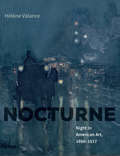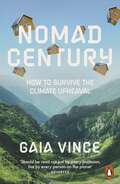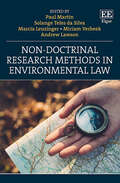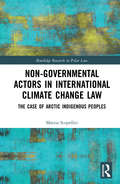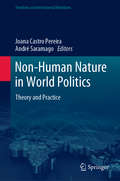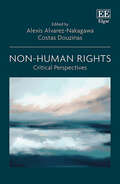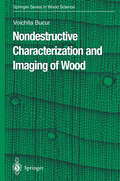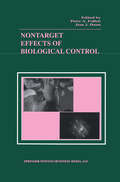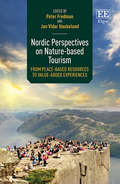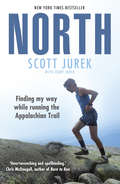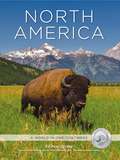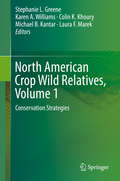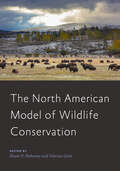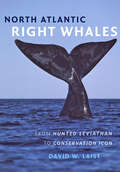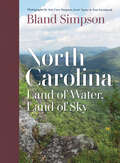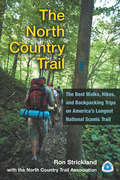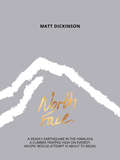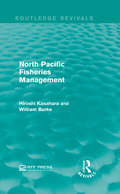- Table View
- List View
Nobody: Alice Oswald And William Tillyer
by Alice OswaldThis is a book-length poem – a collage of water-stories, taken mostly from the Odyssey – about a minor character, abandoned on a stony island. It is not a translation, though, but a close inspection of the sea that surrounds him. There are several voices in the poem but no proper names, although its presiding spirit is Proteus, the shape-shifting sea-god. We recognise other mythical characters – Helios, Icarus, Alcyone, Philoctetes, Calypso, Clytemnestra, Orpheus, Poseidon, Hermes – who drift in and out of the poem, surfacing briefly before disappearing.Reading Nobody is like watching the ocean: a destabilising experience that becomes mesmeric, almost hallucinatory, as we slip our earthly moorings and follow the circling shoal of sea voices into a mesh of sound and light and water – fluid, abstract, and moving with the wash of waves. As with all of Alice Oswald’s work, this is poetry that is made for the human voice, but this poem takes on the qualities of another element: dense, muscular and liquid. one person has the character of dustanother has an arrow for a soulbut their stories all end somewhere in the sea
Noch mehr Sand im Getriebe?: Kommunikations- und Interaktionsprozesse zwischen Landes- und Regionalplanung, Politik und Unternehmen der Gesteinsindustrie (RaumFragen: Stadt – Region – Landschaft)
by Karsten Berr Corinna Jenal Lara Koegst Olaf KühneObwohl mineralische Rohstoffe wie beispielsweise Kies, Sand, Quarz und Naturstein auf vielfältige Weise Grundlagen menschlicher Existenz ermöglichen und garantieren, haben Vorhaben zur Gewinnung mineralischer Rohstoffe vielerorts mit unterschiedlichen Akzeptanzproblemen zu kämpfen. Der planerische Umgang mit Rohstoffsicherung und Rohstoffgewinnung wurde wissenschaftlich bislang hauptsächlich in Bezug auf ökologische oder fachplanerische Problemstellungen, weniger hingegen als teilsystemischer Aspekt in einem soziopolitischen Kontext betrachtet, der durch verstärkten Bürgerprotest und erneuerte Partizipations- und Demokratisierungsbestrebungen gekennzeichnet ist.
Nocturne: Night in American Art, 1890†“1917
by Hélène ValanceA beautifully illustrated look at the vogue for night landscapes amid the social, political, and technological changes of modern America The turn of the 20th century witnessed a surge in the creation and popularity of nocturnes and night landscapes in American art. In this original and thought-provoking book, Hélène Valance investigates why artists and viewers of the era were so captivated by the night. Nocturne examines works by artists such as James McNeill Whistler, Childe Hassam, Winslow Homer, Frederic Remington, Edward Steichen, and Henry Ossawa Tanner through the lens of the scientific developments and social issues that dominated the period. Valance argues that the success of the genre is connected to the resonance between the night and the many forces that affected the era, including technological advances that expanded the realm of the visible, such as electric lighting and photography; Jim Crow–era race relations; America’s closing frontier and imperialism abroad; and growing anxiety about identity and social values amid rapid urbanization. This absorbing study features 150 illustrations encompassing paintings, photographs, prints, scientific illustration, advertising, and popular media to explore the predilection for night imagery as a sign of the times.
Nomad Century: How to Survive the Climate Upheaval
by Gaia VinceLonglisted for the Financial Times Business Book of the Year award'Gaia Vince's new book should be read not just by every politician, but by every person on the planet' ObserverAn urgent investigation of the most underreported, seismic consequence of climate change: how it will force us to change where - and how - we liveWe are facing a species emergency. With every degree of temperature rise, a billion people will be displaced from the zone in which humans have lived for thousands of years. While we must do everything we can to mitigate the impact of climate change, the brutal truth is that huge swathes of the world are becoming uninhabitable. From Bangladesh to Sudan to the western United States, and in cities from Cardiff to New Orleans to Shanghai, the quadruple threat of drought, heat, wildfires and flooding will utterly reshape Earth's human geography in the coming decades. In this rousing call to arms, Royal Society Science Book Prize-winning author Gaia Vince describes how we can plan for and manage this unavoidable climate migration while we restore the planet to a fully habitable state. The vital message of this book is that migration is not the problem - it's the solution. Drawing on a wealth of eye-opening data and original reporting, Vince shows how migration brings benefits not only to migrants themselves, but to host countries, many of which face demographic crises and labour shortages. As Vince describes, we will need to move northwards as a species, into the habitable fringes of Europe, Asia and Canada and the greening Arctic circle. While the climate catastrophe is finally getting the attention it deserves, the inevitability of mass migration has been largely ignored. In Nomad Century, Vince provides, for the first time, an examination of the most pressing question facing humanity.
Non-doctrinal Research Methods in Environmental Law
This timely book explores the innovative non-doctrinal methods currently being used in environmental law research. Drawing on their extensive experience, expert contributors provide insight on how creative approaches to research can improve understanding of lawand policy, leading to more effective legal protection for the environment.Focusing on qualitative research, chapters explain how to use non-doctrinal methods in environmental law research, including in-depth examples of successful uses. Contributors identify the theoretical and practical challenges facing contemporary environmental lawresearchers, providing guidance on designing productive research programs. Alongside practical tips, the book examines the scholarly philosophy of environmental law research, determining how and why it differs from other areas of research. It focuses in particular on how to respect scientific principles when moving away from traditional doctrinal research methods. Non-doctrinal Research Methods in Environmental Law will be an invaluable guide for environmental law academics and researchers seeking to expand their understanding of modern research methods. With extensive case studies and practical guidance, it will also be a useful resource for research methods scholars and teachers.
Non-Governmental Actors in International Climate Change Law: The Case of Arctic Indigenous Peoples (Routledge Research in Polar Law)
by Marzia ScopellitiFocusing on how to improve the participation of non-governmental actors in the making of international climate change laws, this book is a conversation on the relevance of a human rights-based approach to international climate change law-making. The book considers a possible reform of the United Nations Framework Convention on Climate Change institutional arrangement, inspired by the practice and model of participation of Arctic Indigenous Peoples in the Arctic Council. Different non-State entities play a fundamental role in the development and enforcement of the climate change regime by enhancing the knowledge base of decision-making, keeping States in line with their commitments, and engaging in private initiatives aimed at mitigating the impacts of global warming. Albeit non-governmental and subnational actors increasingly work alongside States in the making of a climate change regime, the category of observers through which they participate in intergovernmental negotiations only gives them limited rights and their participation in international norm-making has at times been impaired. The relevance of a human rights-based approach consists in recognising the status of individuals and groups as rights-holders under human rights law, a paradigm that was first established by Arctic Indigenous Peoples when claiming their participatory rights in the Arctic Council, the main forum of governance of the Arctic region. This book argues that, in the absence of a globally binding treaty regulating procedural rights in intergovernmental negotiations, the emerging relationship between human rights and climate change could serve as a legal basis for the enhancement of non-governmental actors’ procedural rights, establishing the right to participation as a right in itself and which can benefit the governance of climate change. Due to the relevance of the addressed subject, the book is destined to a broad readership and will be of use to academic researchers, law practitioners, policy-makers and non-governmental organisations’ representatives.
Non-Governmental Actors in International Climate Change Law: The Case of Arctic Indigenous Peoples (Routledge Research in Polar Law)
by Marzia ScopellitiFocusing on how to improve the participation of non-governmental actors in the making of international climate change laws, this book is a conversation on the relevance of a human rights-based approach to international climate change law-making. The book considers a possible reform of the United Nations Framework Convention on Climate Change institutional arrangement, inspired by the practice and model of participation of Arctic Indigenous Peoples in the Arctic Council. Different non-State entities play a fundamental role in the development and enforcement of the climate change regime by enhancing the knowledge base of decision-making, keeping States in line with their commitments, and engaging in private initiatives aimed at mitigating the impacts of global warming. Albeit non-governmental and subnational actors increasingly work alongside States in the making of a climate change regime, the category of observers through which they participate in intergovernmental negotiations only gives them limited rights and their participation in international norm-making has at times been impaired. The relevance of a human rights-based approach consists in recognising the status of individuals and groups as rights-holders under human rights law, a paradigm that was first established by Arctic Indigenous Peoples when claiming their participatory rights in the Arctic Council, the main forum of governance of the Arctic region. This book argues that, in the absence of a globally binding treaty regulating procedural rights in intergovernmental negotiations, the emerging relationship between human rights and climate change could serve as a legal basis for the enhancement of non-governmental actors’ procedural rights, establishing the right to participation as a right in itself and which can benefit the governance of climate change. Due to the relevance of the addressed subject, the book is destined to a broad readership and will be of use to academic researchers, law practitioners, policy-makers and non-governmental organisations’ representatives.
Non-Human Nature in World Politics: Theory and Practice (Frontiers in International Relations)
by André Saramago Joana Castro PereiraThis book explores the interconnections between world politics and non-human nature to overcome the anthropocentric boundaries that characterize the field of international relations. By gathering contributions from various perspectives, ranging from post-humanism and ecological modernization, to new materialism and post-colonialism, it conceptualizes the embeddedness of world politics in non-human nature, and proposes a reorientation of political practice to better address the challenges posed by climate change and the deterioration of the Earth’s ecosystems. The book is divided into two main parts, the first of which addresses new ways of theoretically conceiving the relationship between non-human nature and world politics. In turn, the second presents empirical investigations into specific case studies, including studies on state actors and international organizations and bodies. Given its scope and the new perspectives it shares, this edited volume represents a uniquely valuable contribution to the field.
Non-Human Rights: Critical Perspectives
Non-human rights are a reality today: this book unpacks their paradoxes as well as their significance for our historic crucible. As animals, rivers, mountains, rainforests, ecosystems, and synthetic entities such as machines, AI, and robots gain recognition as subjects of rights in different parts of the world, non-human rights become part of our ordinary legal landscape and vocabulary. This timely book provides a critical outlook on this rising trend at the crossroads of two of the main concerns of the 21st century: climate change and automation.In seeking to address the foundations, genealogies, philosophies, and impacts of non-human rights, the contributors to this volume examine both their potential and limitations. Are non-human rights just a mere extension of the liberal human rights discourse or, as some suggest, something else and new based on different principles? Are they a ‘revolution’ or just ‘more of the same’? Are they a practical solution that could ‘save us’ from climate disaster and self-destruction through automation or part of the problem and obstacle for social change?This book will be a vital resource for scholars and students of human rights, environmental law, animal rights, law and technology studies, legal theory, socio-legal studies, constitutional law and public international law. Providing an accessible overview of the changing patterns of the rights discourse in contemporary societies, it will also benefit anthropologists, climate and animal rights activists, political scientists, international relations scholars, policy makers and sociologists.
Nondestructive Characterization and Imaging of Wood (Springer Series in Wood Science)
by Voichita BucurThis book on the Nondestructive Characterization and Imaging of Wood by Professor Voichita Bucur is truly the most outstanding reference on the subject ever written. Since the origins of mankind, wood has played a key role in the history of humans and other living creatures, ranging from provision of life from trees giving air, heat, light, and food to nourish their bodies to structures to protect them from the elements. Wood has also played a key role in one of the world's primary religions. Nondestructive diagnostics methods have long found application in medi cal practice for examination of the human body in order to detect life threatening abnormalities and permit diagnosis to extend life. Nondestructive testing has been used for many years to insure the safety of machinery, air craft, railroads, tunnels, buildings and many other structures. Therefore, it is timely for a treatise, like the present one, to be written describing how wood can be characterized without employing destructive test methods. Since wood is so valuable to mankind, it is important to know the latest methods to nondestructively characterize wood for all practical applications.
Nontarget Effects of Biological Control
by Jian J. Duan Peter A. FollettNontarget Effects of Biological Control is the first book of its kind. The environmental safety of biological control has come under scrutiny due to several areas of concerns: the irreversibility of alien introductions, the prevalence of host switching to innocuous native or beneficial species, dispersal of the biocontrol agent to new habitats away from croplands, and the lack of research on the efficacy and impact of biocontrol attempts. The debate has been strongly polarized between conservationists and biological control practitioners. Nontarget Effects of Biological Control proposes that retrospective analyses of systems in place in which nontarget effects are now documented or suspected provide the necessary information for planning and evaluating future releases to reduce risk. The book presents case histories of past biological control introductions from island and continental ecosystems.
Nordic Perspectives on Nature-based Tourism: From Place-based Resources to Value-added Experiences
Nature-based tourism (NBT) is a sector where entrepreneurial success is highly knowledge driven. This insightful book offers a comprehensive evaluation of NBT in a Nordic context, highlighting how long-established Nordic traditions of outdoor recreation practices can reveal lessons for the field more broadly. Featuring contributions from expert scholars, Nordic Perspectives on Nature-Based Tourism examines the links between place-based resources and value-added experiences. It considers the way in which NBT calls for an integrated approach to manage resources for both outdoor recreation and the development of commercial experience products. Chapters explore Nordic and international perspectives, local communities, market dynamics, firms, creativity, innovations and value-added experience products. Undergraduate and graduate students and scholars in tourism and related fields such as geography, planning, hospitality, outdoor recreation and natural resource management will find the knowledge and understanding gained from the book invaluable. It will also prove useful for policymakers, entrepreneurs and volunteers.
North: Finding My Way While Running the Appalachian Trail
by Jenny Jurek Scott Jurek*The New York Times Bestseller*‘Heartwrenching and spellbinding.’ Christopher McDougall, author of Born to Run2,200 miles. 47 days. One remarkable athlete.Scott Jurek takes on the Appalachian Trail.Scott Jurek is one of the greatest ultramarathon runners of all time and a living legend. North tells the story of his biggest challenge, undertaken at the end of a career full of glittering achievements: breaking the speed record for the Appalachian Trail, the famous path that runs for nearly 2,200 miles between Georgia and Maine, almost the entire length of the United States.An ordeal of torturous physical exertion, debilitating sleep deprivation and unimaginable psychological pressure, the run required Jurek to reinvent himself at an age when lesser athletes would have been winding down. Battered by the elements and nearly beaten by an agonising injury, he ran, hiked and stumbled for forty-six days, eleven hours and twenty minutes, covering nearly fifty miles every single day. Always unsure whether he was going to make it to the finish, he was pulled north in pursuit of a lifelong dream.Filled with Jurek’s unique insights into running, as well as compelling descriptions of the awe-inspiring landscape of the Appalachian Trail and its rich history, North will delight runners and non-runners alike and will inspire anyone striving for their personal best.Praise for Scott Jurek‘The greatest ultrarunner of them all.’ New York Times‘Scott Jurek’s record-setting journey on the Appalachian Trail was the most punishing, most demanding, most gruelling feat I’ve ever personally witnessed . . . [North is] an immersive and engaging book.’ Aron Ralston, author of 127 Hours‘Probably America’s greatest ever ultrarunner.’ Guardian‘One of the greatest runners of all time.’ Runner’s World
North America: A World in One Continent
by Huw CordeyThe North American continent stretches over 9.5 million square miles, and is home to more than 500 million people, who share it with hundreds of thousands of species of mammals, birds, insects, and plants-many of them extraordinary, unforgettable, and unique. With 150,000 miles of coastline, North America also has the longest and most abundant shores of any continent on Earth.In the stunning seven-part series from Discovery Channel, renowned nature producer Huw Cordey travels from the Arctic to the Tropics, revealing the wonders of the most dynamic continent on Earth-from the stunning glow of the Aura Borealis in Alaska to the thousands of tornadoes that batter the Great Plains each year to the 55-ton crystals in Mexico's Crystal Cave.North America, the companion book to the television series, follows the producers as they tell the story of this rich and eclectic land through more than 250 gorgeous full-color photographs and engaging essays. Chock-full of interesting facts about the various ecology and wildlife of the many regions of the continent- Prairies, Coasts, Mountains, Freshwater, Deserts, and Forests- North America exposes the continent as you've never seen it before.
North American Crop Wild Relatives, Volume 1: Conservation Strategies
by Stephanie L. Greene Karen A. Williams Colin K. Khoury Michael B. Kantar Laura F. MarekThe plant species that humans rely upon have an extended family of wild counterparts that are an important source of genetic diversity used to breed productive crops. These wild and weedy cousins are valuable as a resource for adapting our food, forage, industrial and other crops to climate change. Many wild plant species are also directly used, especially for revegetation, and as medicinal and ornamental plants. North America is rich in these wild plant genetic resources. This book is a valuable reference that describes the important crop wild relatives and wild utilized species found in Canada, the United States and Mexico. The book highlights efforts taken by these countries to conserve and use wild resources and provides essential information on best practices for collecting and conserving them. Numerous maps using up-to-date information and methods illustrate the distribution of important species, and supplement detailed description on the potential value these resources have to agriculture, as well as their conservation statuses and needs. There is broad recognition of the urgent need to conserve plant diversity; however, a small fraction of wild species is distinguished by their potential to support agricultural production. Many of these species are common, even weedy, and are easily overshadowed by rare or endangered plants. Nevertheless, because of their genetic proximity to agriculturally important crops or direct use, they deserve to be recognized, celebrated, conserved, and made available to support food and agricultural security. This comprehensive two-volume reference will be valuable for students and scientists interested in economic botany, and for practitioners at all levels tasked with conserving plant biodiversity.The chapters 'Public Education and Outreach Opportunities for Crop Wild Relatives in North America' and 'Genetic Resources of Crop Wild Relatives – A Canadian Perspective' are open access under a CC BY 4.0 license via link.springer.com.
North American Crop Wild Relatives, Volume 2: Important Species
by Stephanie L. Greene Karen A. Williams Colin K. Khoury Michael B. Kantar Laura F. MarekThe plant species that humans rely upon have an extended family of wild counterparts that are an important source of genetic diversity used to breed productive crops. These wild and weedy cousins are valuable as a resource for adapting our food, forage, industrial and other crops to climate change. Many wild plant species are also directly used, especially for revegetation, and as medicinal and ornamental plants. North America is rich in these wild plant genetic resources. This book is a valuable reference that describes the important crop wild relatives and wild utilized species found in Canada, the United States and Mexico. The book highlights efforts taken by these countries to conserve and use wild resources and provides essential information on best practices for collecting and conserving them. Numerous maps using up-to-date information and methods illustrate the distribution of important species, and supplement detailed description on the potential value these resources have to agriculture, as well as their conservation statuses and needs. There is broad recognition of the urgent need to conserve plant diversity; however, a small fraction of wild species is distinguished by their potential to support agricultural production. Many of these species are common, even weedy, and are easily overshadowed by rare or endangered plants. Nevertheless, because of their genetic proximity to agriculturally important crops or direct use, they deserve to be recognized, celebrated, conserved, and made available to support food and agricultural security. This comprehensive two-volume reference will be valuable for students and scientists interested in economic botany, and for practitioners at all levels tasked with conserving plant biodiversity.
The North American Model of Wildlife Conservation (Wildlife Management and Conservation)
by Shane P. Mahoney Valerius GeistAt the end of the nineteenth century, North America suffered a catastrophic loss of wildlife driven by unbridled resource extraction, market hunting, and unrelenting subsistence killing. This crisis led powerful political forces in the United States and Canada to collaborate in the hopes of reversing the process, not merely halting the extinctions but returning wildlife to abundance. While there was great understanding of how to manage wildlife in Europe, where wildlife management was an old, mature profession, Continental methods depended on social values often unacceptable to North Americans. Even Canada, a loyal colony of England, abandoned wildlife management as practiced in the mother country and joined forces with like-minded Americans to develop a revolutionary system of wildlife conservation. In time, and surviving the close scrutiny and hard ongoing debate of open, democratic societies, this series of conservation practices became known as the North American Model of Wildlife Conservation.In this book, editors Shane P. Mahoney and Valerius Geist, both leading authorities on the North American Model, bring together their expert colleagues to provide a comprehensive overview of the origins, achievements, and shortcomings of this highly successful conservation approach. This volume• reviews the emergence of conservation in late nineteenth–early twentieth century North America• provides detailed explorations of the Model's institutions, principles, laws, and policies• places the Model within ecological, cultural, and socioeconomic contexts• describes the many economic, social, and cultural benefits of wildlife restoration and management• addresses the Model's challenges and limitations while pointing to emerging opportunities for increasing inclusivity and optimizing implementationStudying the North American experience offers insight into how institutionalizing policies and laws while incentivizing citizen engagement can result in a resilient framework for conservation. Written for wildlife professionals, researchers, and students, this book explores the factors that helped fashion an enduring conservation system, one that has not only rescued, recovered, and sustainably utilized wildlife for over a century, but that has also advanced a significant economic driver and a greater scientific understanding of wildlife ecology.Contributors: Leonard A. Brennan, Rosie Cooney, James L. Cummins, Kathryn Frens, Valerius Geist, James R. Heffelfinger, David G. Hewitt, Paul R. Krausman, Shane P. Mahoney, John F. Organ, James Peek, William Porter, John Sandlos, James A. Schaefer
The North American Model of Wildlife Conservation (Wildlife Management and Conservation)
by Shane P. Mahoney Valerius GeistAt the end of the nineteenth century, North America suffered a catastrophic loss of wildlife driven by unbridled resource extraction, market hunting, and unrelenting subsistence killing. This crisis led powerful political forces in the United States and Canada to collaborate in the hopes of reversing the process, not merely halting the extinctions but returning wildlife to abundance. While there was great understanding of how to manage wildlife in Europe, where wildlife management was an old, mature profession, Continental methods depended on social values often unacceptable to North Americans. Even Canada, a loyal colony of England, abandoned wildlife management as practiced in the mother country and joined forces with like-minded Americans to develop a revolutionary system of wildlife conservation. In time, and surviving the close scrutiny and hard ongoing debate of open, democratic societies, this series of conservation practices became known as the North American Model of Wildlife Conservation.In this book, editors Shane P. Mahoney and Valerius Geist, both leading authorities on the North American Model, bring together their expert colleagues to provide a comprehensive overview of the origins, achievements, and shortcomings of this highly successful conservation approach. This volume• reviews the emergence of conservation in late nineteenth–early twentieth century North America• provides detailed explorations of the Model's institutions, principles, laws, and policies• places the Model within ecological, cultural, and socioeconomic contexts• describes the many economic, social, and cultural benefits of wildlife restoration and management• addresses the Model's challenges and limitations while pointing to emerging opportunities for increasing inclusivity and optimizing implementationStudying the North American experience offers insight into how institutionalizing policies and laws while incentivizing citizen engagement can result in a resilient framework for conservation. Written for wildlife professionals, researchers, and students, this book explores the factors that helped fashion an enduring conservation system, one that has not only rescued, recovered, and sustainably utilized wildlife for over a century, but that has also advanced a significant economic driver and a greater scientific understanding of wildlife ecology.Contributors: Leonard A. Brennan, Rosie Cooney, James L. Cummins, Kathryn Frens, Valerius Geist, James R. Heffelfinger, David G. Hewitt, Paul R. Krausman, Shane P. Mahoney, John F. Organ, James Peek, William Porter, John Sandlos, James A. Schaefer
North Atlantic Right Whales: From Hunted Leviathan to Conservation Icon
by David W. LaistIn the cold waters of the unforgiving North Atlantic Ocean, some of the heartiest humans of medieval days ventured out in search of whales. Through the centuries, people on both sides of the Atlantic became increasingly dependent on whale oil and other cetacean products. To meet this growing demand, whaling became ever more sophisticated and intense, leading to the collapse of what was once a seemingly inexhaustible supply of large cetaceans. Central to the whale's subsequent struggle for existence has been one species;¢;‚¬;€?the North Atlantic right whale. Conservationist David W. Laist now provides the first complete history of the North Atlantic right whale, from its earliest encounters with humans to its close brush with extinction, to its currently precarious yet hopeful status as a conservation icon.Favored by whalers because of their high yields of oil and superior baleen, these giants became known as "the right whale to hunt," and their numbers dwindled to a mere 100 individuals worldwide. Their dire status encouraged the adoption of a ban on hunting and a treaty that formed the International Whaling Commission. Recovery of the species, however, has proven elusive. Ship strikes and entanglement in commercial fishing gear have hampered herculean efforts to restore the population. Today, only about 500 right whales live along the US and Canadian Atlantic coasts;¢;‚¬;€?an improvement from the early twentieth century, but still a far cry from the thousands that once graced Atlantic waters.Laist's masterpiece features an incredible collection of photographs and artwork that give life to the fascinating history that unfolds in its pages. The result is a single volume that offers a comprehensive understanding of North Atlantic right whales, the role they played in the many cultures that hunted them, and our modern attempts to help them recover.
North Atlantic Right Whales: From Hunted Leviathan to Conservation Icon
by David W. LaistIn the cold waters of the unforgiving North Atlantic Ocean, some of the heartiest humans of medieval days ventured out in search of whales. Through the centuries, people on both sides of the Atlantic became increasingly dependent on whale oil and other cetacean products. To meet this growing demand, whaling became ever more sophisticated and intense, leading to the collapse of what was once a seemingly inexhaustible supply of large cetaceans. Central to the whale's subsequent struggle for existence has been one species;¢;‚¬;€?the North Atlantic right whale. Conservationist David W. Laist now provides the first complete history of the North Atlantic right whale, from its earliest encounters with humans to its close brush with extinction, to its currently precarious yet hopeful status as a conservation icon.Favored by whalers because of their high yields of oil and superior baleen, these giants became known as "the right whale to hunt," and their numbers dwindled to a mere 100 individuals worldwide. Their dire status encouraged the adoption of a ban on hunting and a treaty that formed the International Whaling Commission. Recovery of the species, however, has proven elusive. Ship strikes and entanglement in commercial fishing gear have hampered herculean efforts to restore the population. Today, only about 500 right whales live along the US and Canadian Atlantic coasts;¢;‚¬;€?an improvement from the early twentieth century, but still a far cry from the thousands that once graced Atlantic waters.Laist's masterpiece features an incredible collection of photographs and artwork that give life to the fascinating history that unfolds in its pages. The result is a single volume that offers a comprehensive understanding of North Atlantic right whales, the role they played in the many cultures that hunted them, and our modern attempts to help them recover.
North Carolina: Land of Water, Land of Sky
by Bland SimpsonBland Simpson, the celebrated bard of North Carolina's sound country, has blended history, observation of nature, and personal narrative in many books to chronicle the people and places of eastern Carolina. Yet he has spent much of his life in the state's Piedmont, with regular travels into its western mountains. Here, for the first time, Simpson brings his distinctive voice and way of seeing to bear on the entirety of his home state, combining storytelling and travelogue to create a portrait of the Old North State with care and humor. Three of the state's finest photographers come along to guide the journey: Simpson's wife and creative partner, Ann Cary Simpson, professional photographer Scott Taylor, and writer and naturalist Tom Earnhardt. Their photos, combined with Simpson's rich narrative, will inspire readers to consider not only what North Carolina has been and what it is but also what we hope it will be. This book belongs on the shelf of longtime residents, newcomers, and visitors alike.
The North Country Trail: The Best Walks, Hikes, and Backpacking Trips on America’s Longest National Scenic Trail
by Ron Strickland North Country AssociationThe North Country Trail is the longest of America’s eleven congressionally designated National Scenic Trails. Winding through seven states—New York, Pennsylvania, Ohio, Michigan, Wisconsin, Minnesota, and North Dakota—the NCT’s 4,600 miles attract more than one million visitors annually. These hikers are treated to a smorgasbord of Upper Midwest hiking featuring everything from urban strolls to backcountry adventure through mountains, rivers, prairies, and shoreline. This book is the definitive guide for NCT hikers—whether first-timers, seasoned backpackers, or any level in between—who wish to maximize their experience on this splendid trail. In addition to a full overview of the trail’s tread in each state, the guide describes in detail forty of the NCT’s premier segments, with helpful information including easy-to-read trail descriptions, physical and navigation difficulties, trail highlights, hiking tips, and precise maps incorporating the latest GPS technology.
North Face: A Deadly Earthquake In The Himalaya. A Climber Trapped High On Everest. An Epic Rescue Attempt Is About To Begin. (The Everest Files #2)
by Matt DickinsonThe Everest Files story continues in 'North Face' ... Ryan Hart is an 18-year-old adventurer on a mission. To get himself to Mount Everest and check out the truth about the world's highest peak. Friends have told him dark stories about the mountain, outrageous things that he wants to see for himself. Just a few hours after Ryan arrives at Everest Base Camp a lethal earthquake strikes. Avalanches pound the glacier, burying Ryan's climbing buddy and killing many others. A desperate rescue saves Ryan's friend, but only after a local Tibetan girl -Tashi - helps with the search. Stress levels are running high among the climbing teams. The mountain is shut for the season because it is judged too dangerous. Then a flashlight reveals a clue. Someone is alive, high on Everest's treacherous north face!Tashi is convinced it is her 15-year-old brother. Ryan is prepared to risk everything to help. Storm clouds gather as they set out on their illegal climb, a do-or-die mission which the local militia will do anything to stop.
North Pacific Fisheries Management (Routledge Revivals)
by Hiroshi Kasahara William BurkeIn anticipation of the UN Conference of the Law of the Sea taking place in 1973, Dr Kasahara and Dr Burke of the University of Washington first published North Pacific Fisheries Management earlier that year. The conference brought fishery territories to a global stage with delegates that may not be as informed about ocean issues as those previously making decisions. Therefore the Program of International Studies of Fishery Arrangements was created to explore the management of fisheries in specific regions. This study focusses on the North Pacific region and delves into the implications of a global regime, generic problems concerning fishery management, distribution and institutions as well as alternative arrangements that can be made to make the management of fisheries smoother. This title will be of interest to students of environmental studies and policy makers.


